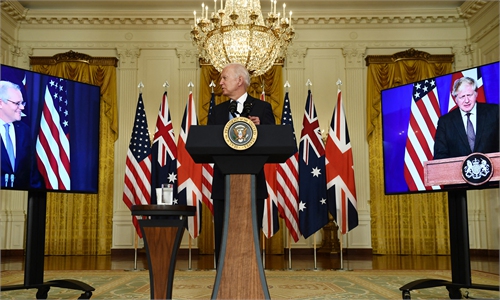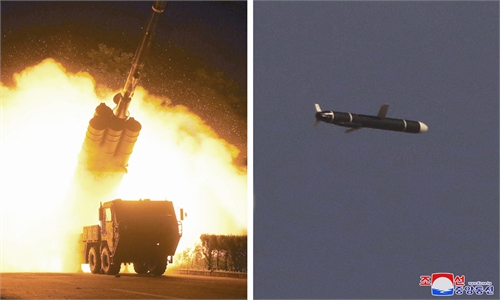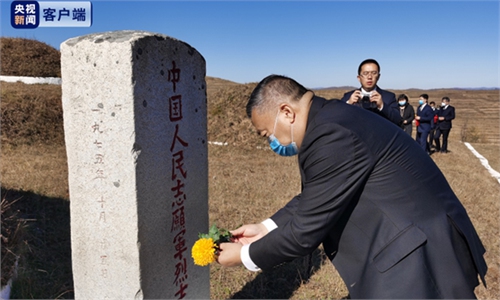N.Korea reports new hypersonic missile test; US, Japan hypes move
Japan’s military expansion more dangerous than tests of North Korea: expert
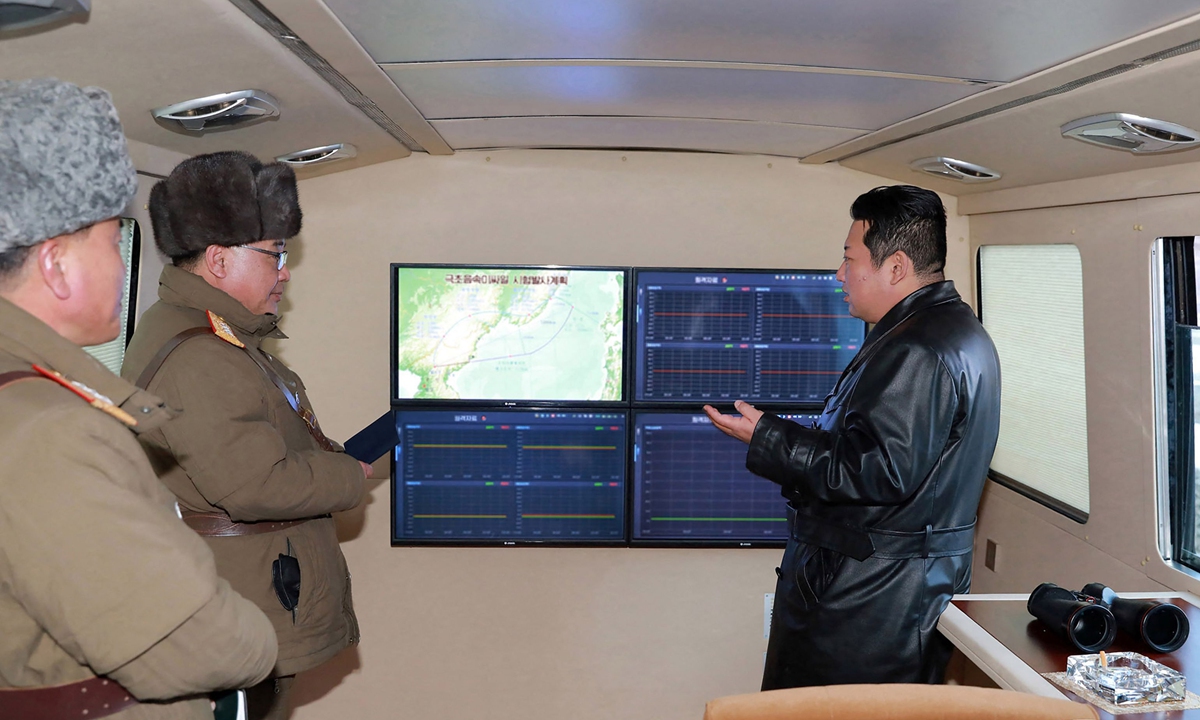
North Korean leader Kim Jong-un attends a test-fire of hypersonic missile conducted by the Academy of Defense Science of the DPRK. Photo: VCG
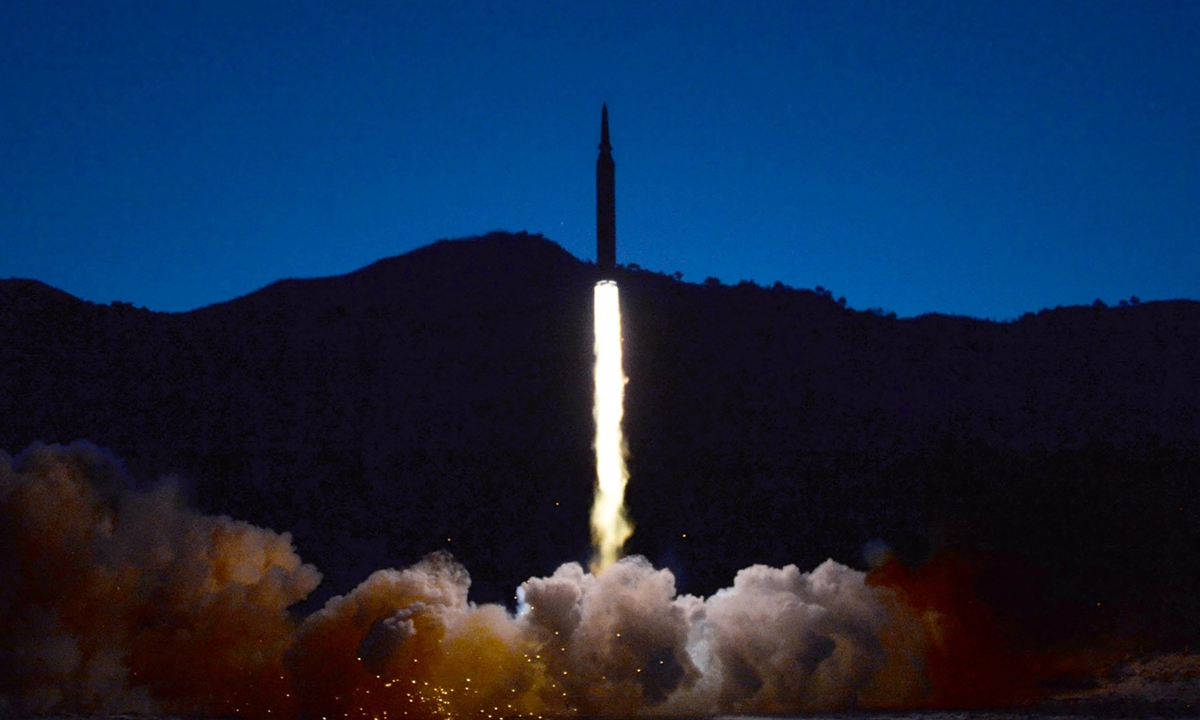
North Korea conducts a hypersonic missile test-fire, according to KCNA. Photo: VCG
North Korea on Wednesday reported the latest test of a hypersonic missile with the witness of North Korean leader Kim Jong-un and missile analysts pointed out related data revealed that North Korea may have acquired the technologies but still needs more tests to demonstrate and enhance the weapon's accuracy.While the series of tests had not broken the arms balance in the region, Japan and the US are hyping the so-called threat to reinforce own military build-up, analysts said, saying the US' double standards have led to a de facto arms race that jeopardizes regional peace.
The test on Tuesday was aimed at the final verification of overall technical specifications of the developed hypersonic weapon system, the KCNA reported.
After its release from the missile, the hypersonic glide vehicle made glide jump flight from 600 kilometer before making a 240 kilometer corkscrew maneuver from the initial launch azimuth to the target azimuth, and hit the set target in waters 1,000 kilometers away, the KCNA report said.
The superior maneuverability of the hypersonic glide vehicle was more strikingly verified through the final test, the KCNA said.
The information released by North Korea remains limited, not enough to judge if the weapon is indeed a hypersonic weapon, but it gives many clues toward that conclusion, Wang Ya'nan, the chief editor of Beijing-based Aerospace Knowledge magazine, told the Global Times on Wednesday.
The glide jump flight from 600 kilometers reflected a key characteristic of hypersonic weapons, as it shows that the weapon does not make a direct freefall on its target like a ballistic missile, but made a trajectory change to a lower and flatter trajectory, Wang said.
The 240-kilometer corkscrew maneuver is even more challenging, because maneuvering is very challenging in hypersonic flight, and this corkscrew maneuver is likely performed to not only evade interception, but also to bide time for the missile to search for and lock on its target, Wang explained.
Tuesday's test is the third such launch announced by the KCNA.
The first test was announced on September 29, 2021, which confirmed the navigational control and stability of the missile in the active section and also its technical specifications including the guiding maneuverability and the gliding flight characteristics of the detached hypersonic gliding warhead, the KCNA reported at the time, noting that it also ascertained the stability of the engine as well as of missile fuel ampoule introduced for the first time.
The second test, announced by the KCNA on January 6, reconfirmed the flight control and stability of the missile in the active-flight stage and assessed the performance of the new lateral movement technique applied to the detached hypersonic gliding warhead.
More details were given this time, as the KCNA revealed that the missile made a 120 kilometers lateral movement in the flight distance of the hypersonic gliding warhead from the initial launch azimuth to the target azimuth and precisely hit a set target 700 kilometers away, and the reliability of the fuel ampoule system under winter conditions was also verified.
Comparing the reports on the three tests, more challenging technologies were tested with each, observers pointed out.
While these tests provided some insights into North Korea's rapid hypersonic weapon development, analysts remain uncertain about the weapon's true capability in combat.
While a hypersonic speed of higher than Mach 5 can be easily achieved with a booster rocket used by any ballistic missile, and the glide vehicle can seemingly make glide jumps and maneuvers that qualifies the weapon as hypersonic, the terminal-phase guidance is the most challenging technology to make the weapon useful, Wang said.
It requires a very complex and coordinated work of sensors, hypersonic flight control and probably also data transfer from satellites, drones and large reconnaissance aircraft to guide the weapon to its target, Wang said, questioning if all these problems have been solved.
North Korea has put many resources to develop the hypersonic weapon, and some progress must have been made, but whether the weapon can hit its target accurately as the report claimed cannot be verified as for now, Wang said.
The test showed the missile's hypersonic speed and high maneuverability it needs to penetrate hostile defenses. But convincing evidence needs to be shown in order for the public to know if the missile can hit its target accurately, according to Wang.
The continuous tests showcased North Korea's eagerness to acquire the technologies of hypersonic missiles in dealing with the challenges brought by missile defense systems built by the US, Japan and South Korea, said Chinese military expert and commentator Song Zhongping.
Song told the Global Times that development of ballistic or hypersonic missiles is more like a shortcut to bolster North Korea's defense capability given its lack of advanced aircraft or other surface ships. Hypersonic missiles, with its ability to hit targets in the blink of an eye, would make the US, Japan and South Korea think twice before taking rash actions.
Warning to Japan, US
North Korean leader Kim Jong-un attended the Tuesday test, KCNA reported.
Kim's high-profile appearance shows North Korea wants to showcase the breakthrough on new technologies and to maintain domestic morale, said Lü Chao, a fellow at the Liaoning Academy of Social Sciences, noting that it is also a political tradition and gesture to launch missiles and also attend the launching before important festivals.
The expert told the Global Times that North Korea will embrace the 80th anniversary of the Day of the Shining Star on February 16, a public holiday to celebrate the birth of the country's second leader Kim Jong-il.
North Korea also wants to remind the US to be engaged or have negotiations with it given that the discussions at the UN on lifting its sanctions is being stalled by the US, and the Biden administration seems to have adopted the silent treatment to North Korea from the Obama era, Lü said.
Song said North Korea tested hypersonic missiles to pressure the US and its hostile policy. As long as North Korea faces severe challenges to its political system and security from the US, it will take all measures as defense.
The expert said the US and Japan are twisting the concept of denuclearization of the Korean Peninsula into "denuclearization of North Korea" - supporting Japan to develop its military capability while sanctioning North Korea - which North Korea and China would not allow.
"Under US double standards, an arms race has already started," Song noted.
North Korea's Tuesday test came on the heels of the high-level "2-plus-2" meetings between the US secretary of state and secretary of defense and the Japanese foreign minister and defense minister, during which they signed agreements to develop counter hypersonic capabilities targeting China and North Korea.
The Japanese Prime Minister Fumio Kishida met with Australian Prime Minister Scott Morrison on January 6 and signed a reciprocal access agreement to ramp up defense cooperation, a pact that experts said could inflame regional tensions.
The North Korea tests did not break the arms balance between North and South Korea or between North Korea and Japan. But Japan is hyping it as an opportunity to expand a military build-up and some Japanese right-wing politicians even urged the development of nuclear weapons by Japan, Lü told the Global Times.
"Japan's military expansion is more dangerous to regional countries than the tests of North Korea," said Lü.
Analysts noted that by hyping threats from North Korea, Japan also aims to revise the Peace Constitution and further push to the right for collective self-defense, which has already started.
Kyodo News reported that Japanese Prime Minister Fumio Kishida on Tuesday condemned North Korea's actions and called the continuing launches "extremely regrettable." Japanese officials have been asked to be prepared to respond to any emergency. On the same day, White House Press Secretary Jen Psaki called the North Korean launch "destabilizing."
US announced on Wednesday to sanction five North Koreans after the missile launch.
Experts noted that South Korea responded to the news calmly.
South Korea responded to the tests with an emergency meeting of the National Security Council and President Moon Jae-in expressed concerns over the series of launches coming ahead of the South Korean presidential election on March 9. Some South Korean officials also cast doubt on the capability of the hypersonic missile North Korea claimed to have tested. No stronger or any actions that may be seen as "provocations" have been made by South Korea.
Lü said his friends in South Korea said that the government is closely monitoring the tests and South Koreans are also paying close attention to the tests. But more people in South Korea are holding a wait-and-see attitude, and few want to hype the issue.
China's stance is consistent and hopes every party solves Korean Peninsula issues with the "dual track" approach, Wang Wenbin, spokesperson of the Chinese Foreign Ministry, told a press conference on Wednesday, in response to the test-launch.
China also firmly opposes actions that will destroy the peace and stability of the Korean Peninsula and is working to draw related parties to go back to the negotiating table, Lü said.
Lü noted that considering that Biden administration is struggling with tensions with Russia in Ukraine and tons of domestic problems, he may have no time to deal with Korean Peninsula issues. The joint military drill between South Korea and the US may be an important timing to observe whether there will be changes in US policy toward North Korea.


